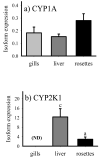Characterization of Phase I biotransformation enzymes in coho salmon (Oncorhynchus kisutch)
- PMID: 17826357
- PMCID: PMC2694037
- DOI: 10.1016/j.cbpc.2007.08.001
Characterization of Phase I biotransformation enzymes in coho salmon (Oncorhynchus kisutch)
Abstract
Wild stocks of Pacific salmon in the Northwestern United States have declined in recent years, and the major factors contributing to these losses include water pollution and loss of habitat. In salmon, sublethal chemical exposures may impact critical behaviors (such as homing, feeding, predator-avoidance) that are important for species survival. Therefore, understanding the potential for these species to biotransform organic compounds within sensitive target tissues such as liver, gills and olfactory region can help estimate or predict their susceptibility to pollutants. In this study, we used real-time quantitative polymerase chain reaction (Q-PCR), Western blotting, and catalytic assays to characterize the expression of Phase I biotransformation enzymes in coho salmon (Oncorhynchus kisutch), a sensitive species in the Pacific Northwest. Gene expression analysis using Q-PCR assays developed for coho genes revealed the presence of the predominant cytochrome P450 mRNAs (CYP1A, CYP2K1, CYP2M1, CYP3A27) in the olfactory rosettes and provided quantitative mRNA expression levels in coho liver and gills. Q-PCR analysis revealed relatively high expression of the major CYP isoforms in the liver and olfactory rosettes, which was generally confirmed by Western blotting. Extrahepatic CYP expression was generally higher in the olfactory rosettes as compared to the gills. Catalytic studies demonstrated functional CYP1A-dependent ethoxyresorufin-O-deethylase, CYP2-dependent pentoxyresorufin-O-dealkylase, CYP2K1-dependent testosterone 16beta-hydroxylase, and CYP3A27-dependent testosterone 6beta-hydroxylase activities in liver, but not at detectable levels in gills. In contrast, flavin-containing monooxygenase (FMO)-dependent thiourea S-oxidase activity was readily observed in the gills and was substantially higher than that observed in liver. Collectively, the results of this study suggest that the olfactory rosettes are important sites of extrahepatic biotransformation in coho salmon, and that tissue specific-differences in Phase I metabolism may lead to contrasting tissue-specific biotransformation capabilities in this species.
Figures



References
-
- Buhler DR, Miranda CL, Deinzer ML, Griffin DA, Henderson MC. The regiospecific hydroxylation of lauric acid by rainbow trout (Oncorhynchus mykiss) cytochrome P450s. Drug Metab Dispos. 1997;25:1176–1183. - PubMed
-
- Buhler DR, Miranda CL, Henderson MC, Yang YH, Lee SJ, Wang-Buhler J-L. Effects of 17 beta-estradiol and testosterone on hepatic mRNA/protein levels and catalytic activities of CYP2M1, CYP2K1, and CYP3A27 in rainbow trout (Oncorhynchus mykiss) Toxicol Appl Pharmacol. 2000;168:91–101. - PubMed
-
- Buhler DR, Wang-Buhler J-L. Rainbow trout cytochrome P450s: purification, molecular aspects, metabolic activity, induction and role in environmental monitoring. Comp Biochem Physiol C. 1998;121:107–137. - PubMed
-
- Burke MD, Thompson S, Weaver RJ, Wolf RC, Mayer RT. Cytochrome P450 specificities of alkoxyresorufin O-dealkylation in human and rat liver. Biochem Pharmacol. 1994;48:923–936. - PubMed
-
- Cao Z, Hong J, Peterson RE, Aiken JM. Characterization of CYP1A1 and CYP1A3 gene expression in rainbow trout (Oncorhynchus mykiss) Aquatic Toxicol. 2000;49:101–109. - PubMed
Publication types
MeSH terms
Substances
Grants and funding
LinkOut - more resources
Full Text Sources

